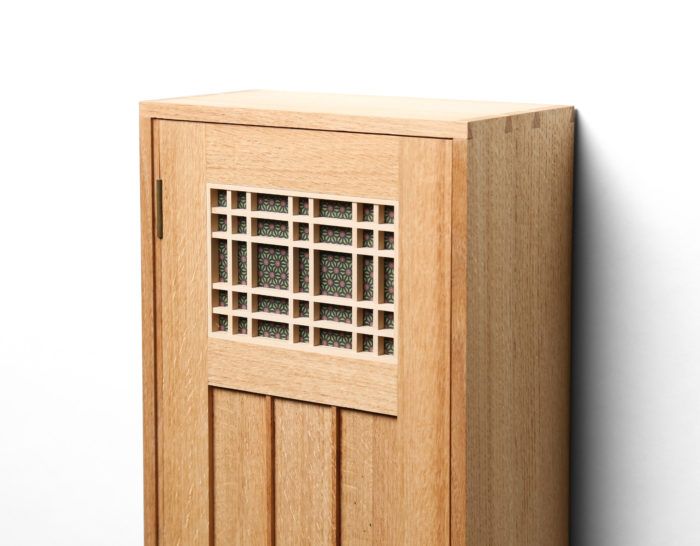Good design takes wood species into account
How a chunk of red oak forced me to rethink the details of a cabinet
I love riftsawn cherry. It’s a quiet wood with tight, straight grain, and smooth texture that complements the crisp, modern lines of the furniture I make. It stands back, allowing the proportions and geometric patterns created by the drawers and doors to shine. There are species and cuts of wood that would not work so well with my aesthetic. Quartersawn white oak, with its dominant ray fleck figure,  would struggle against the clean, sleek lines I prefer. Red oak is another species that wouldn’t pair well with my sense of design, which is why I found myself a bit perplexed earlier this year. I had a big chunk of red oak (6 in. square and 36 in. long) and needed to make something from it (why I needed to is a story I won’t go into here).
would struggle against the clean, sleek lines I prefer. Red oak is another species that wouldn’t pair well with my sense of design, which is why I found myself a bit perplexed earlier this year. I had a big chunk of red oak (6 in. square and 36 in. long) and needed to make something from it (why I needed to is a story I won’t go into here).
Initially, I was perplexed about what to do. I’d have to step outside my normal aesthetic to be successful. Fortunately, I was able to resaw the chunk to control the grain. I got six perfectly quartersawn boards from the timber. (I would not use flatsawn red oak to make anything. To paraphrase the wife on one of those StateFarm commercials: It looks hideous.) That helped, because quartersawn wood has straight grain, and the ray fleck in red oak is much more subdued than the ray fleck in white oak. Still, there is figure. And then there’s the problem of (apparent) texture. Red oak, with its big, open pores, is much rougher in appearance than cherry. I needed to adjust my design to fit better with these characteristics of red oak.
Here’s what I did: I stole from Mike Pekovich, who works with quartersawn white oak. It’s always a good idea to steal from Mike, because he’s a great designer. Specifically, I inset the door and drawers, and used two vertical dividers to break up the lower door panel. I also used butt hinges instead of knife hinges. The hinges are mortised into a hinge strip, a brilliant and necessary detail that allows the inset door to swing fully open on butt hinges. I don’t know if I can explain why these small changes make the cabinet better suited for oak, but they do. Still, they don’t override my own aesthetic. It looks like a cabinet that I made, instead of one that Mike made. This is because of my sense of proportion, which is different from his, my penchant for having two rows of drawers with the top row divided unevenly, my love for flush dovetail joinery, and my stripped-down take on kumiko. (Mike is more of traditionalist when it comes to kumiko.) Of course, the fact that I used this style of pull, which I developed while working on my 52 boxes in 52 weeks project, doesn’t hurt to mark the cabinet as mine. In the end, I think I ended up with a cabinet that is clearly mine, but tailored for the wood species used. And that’s the whole point of this: The characteristics of the wood you’re using (cut, tightness of the grain, size of the pores, color, etc.) are important details that you must consider when designing.
If you’d like to read more about what I was thinking during the design stage, take a look here. Also, I don’t think it’s a bad thing to steal from another furniture maker. It’s much worse to borrow. Here’s my reasoning for this.
Fine Woodworking Recommended Products

Blackwing Pencils

Drafting Tools

Ridgid R4331 Planer























Comments
Hello Matt,
Beautiful design! What type of finish did you use? It avoids that that "golden oak" color and has a nice natural, unstained look.
Thanks,
David
Mr kenney,
This realy is a lovely cabinet, one of your best so far. When i saw the picture of the top my heart skipped a bit and the thought was "this is the best ive seen in quiet desien in years". But when the full view rolled in, i thought there were a little too many things going on.
I believe that to get a quiet design you need to have no more than three elements working at the same time from any point of view. Since the change of grain direction in the oak from door front to drawer fronts breaks this rule it is not quiet enough for me.
To make it work i would have forgone the contrasting pulls and used shaker pulls turned from the same wood or side latches that are not visible from the front.
djcook50: I used shellac and only shellac. No stains.
slowman,
Thanks for your comments. Perhaps it goes without saying, but I don't agree. I especially don't agree that a turned Shaker pull would look better than the ones I used. This is not a Shaker cabinet. A Shaker pull would look terrible. Also, there are neither too many nor too few things going, but the exact number I intended.
I really enjoyed the blog. When I saw the pictures on instagram I originally thought I was looking at Mr. Pekovich's work. When I saw the completed project, my first thought was a collaboration piece; the bottom is distinctly your aesthetic. In the end I enjoy the piece but love understanding the thought process behind it. I hope to read more of these type of blog post. Thank you.
Wouldn't you get a very similar effect with rift sawn white oak? I have a kitchen full of cabinets I made from that in a Stickley style but with flush panels?
Really nice cabinet. I enjoy learning why woodworkers/artists make particular design decisions. I may not naturally gravitate toward a certain style, but if they're accomplished, I'll still usually appreciate/respect their finished piece. And along the way, I'll usually learn a couple things.
Awesome design! i like it
Thank you for the inspiration. I requested white oak but have several hundred board feet of red oak from my deceased in-laws farm which will be a challenge for me to use meaningfully. The details of your build and finish applied help.
It seems to me that red oak, in addition to its flooring applications, is also used extensively in stair parts like, spindles, newels and rails in addition to treads. Maybe this is just an extension of its use in flooring? But there may also be a feature of wood turning that brings out hidden features of red oak.
I assume that most of the oak in furniture like that of the Arts & Crafts movement is white oak (though I have not checked this). Your use of white oak in a piece of fine cabinetry may be in keeping with a lot of prior art but your design takes it in a completely new direction. Beautiful!
I think the sophistication of design one element that separates a fine woodworker from the larger body of skilled craftsmen. And design is an ability that is notoriously hard to teach. Thank you for sharing your thoughts Matt!
Log in or create an account to post a comment.
Sign up Log in